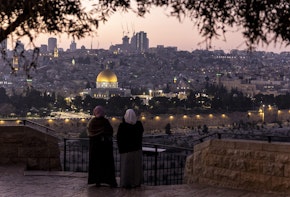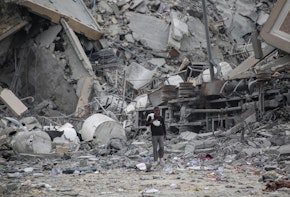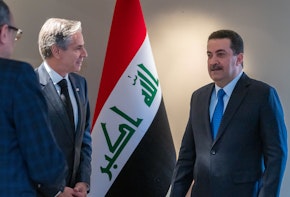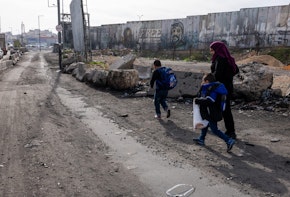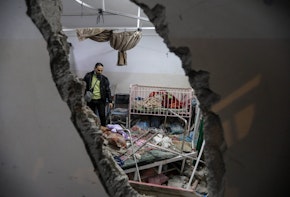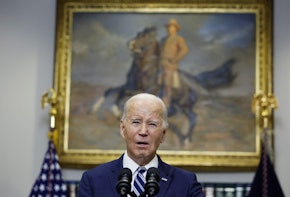In April, the Syrian government announced an amnesty of its political opponents that goes further than previous pardons. The amnesty, and how Syrian officials have since presented it to foreign counterparts, may indicate a shift in how Damascus is looking to engage with the outside world.
Syrian president Bashar al-Assad decreed an amnesty for Syrians accused of “terrorism”—a charge that Syrian authorities have used to justify the detention of not only Syrian opposition militants but also dissidents more broadly, including activists and aid workers. Syrian authorities have since reportedly released more than five hundred detainees, including some they have held prisoner since the first years of the country’s conflict, which is now more than a decade old. These freed detainees are only a fraction of the tens of thousands imprisoned and missing in Syria. Still, if the government continues to release more dissidents from its prisons, it could be the beginning of something more significant.
In parallel, Syrian officials have told foreign interlocutors that this amnesty decree is a major turning point in Syria’s domestic efforts at reconciliation—and, implicitly, signaled that they are seeking a new, more reciprocal dynamic with countries that have been opposed to Assad’s government. Damascus’s implementation of this amnesty decree has not yet been enough for these countries to offer something in return. But that might change if Damascus does more to carry out the decree fully and transparently.
This report draws on almost a dozen interviews with diplomats, international officials, and others familiar with both the amnesty’s implementation and how Syrian officials have externally communicated the decree. Most requested anonymity to speak freely.
Syria’s latest amnesty could come to nothing, as has been the case with other amnesties announced by Damascus in the past. It could also become something more, however—but only if Damascus is willing to realize the decree’s evident potential.
A Newly Expansive Amnesty
On April 30, Assad issued Legislative Decree No. 7 (2022), which declared a general amnesty for Syrians who had committed “terrorist crimes” under Syria’s 2012 Counterterrorism Law and provisions of the country’s penal code that predated the 2012 law.1 The amnesty excluded crimes that resulted in a person’s death and civil suits filed by individuals.
This decree was the Syrian government’s first amnesty specifically for terror offenses, and it was unprecedented in its scope. The Syrian government has, by one count, announced eighteen prior amnesties since the beginning of Syria’s uprising in 2011.2 Yet past amnesties have been much more conditional, and the number of prisoners and detainees released under those amnesties has been relatively limited.
The April decree, by contrast, offered a nearly blanket amnesty for offenses under the country’s Counterterrorism Law. Syrian authorities have used the vaguely worded 2012 law to arbitrarily pursue political opponents, ranging from Syrian opposition militants to nonviolent activists.3
The April 30 amnesty decree is very brief—essentially just three short paragraphs—which leaves substantial uncertainty about its legal implications. The text of the amnesty and subsequent statements by Syrian officials, however, have indicated that the amnesty applies to Syrians who are in pretrial detention, are on trial, or have been convicted and sentenced.4 It also vacates warrants for Syrians who are not in state custody, although it is not clear if it additionally pertains to Syrian security services’ unofficial wanted lists.5 The decree’s effect is apparently automatic; Syrians are not required to appear before authorities or take other action to benefit from the amnesty.
The April 30 amnesty decree is just three short paragraphs—which leaves substantial uncertainty about its legal implications.
“There is some potential in the implementation of this amnesty, with possibly far-reaching implications, provided it is applied consistently and in line with international human rights law and standards,” said a researcher with a human rights organization who spoke on condition of anonymity. “On paper, because the [counterterrorism] law has been used so extensively, the effects of this could be huge.”6
After the decree was issued, Syrian authorities promptly released hundreds of detainees, including some political detainees in custody since 2011 and 2012.7 The Syrian Network for Human Rights has reported that, as of July 15, Damascus had released 547 detainees.8 Most were freed in the first week after the decree, but releases have continued since.9
The head of Syria’s counterterrorism court told state television on May 4 that after the decree was issued, the court’s staff immediately began to review the cases of Syrians detained pending trial or sentenced to prison, and had started, incrementally, to order their release.10 “Since April 30, 2022, hundreds of those covered by the amnesty have been released,” she said. “The other, remaining files are still under review, and I am at the court with a full staff to ensure the dossiers of those remaining are handled.” The head of Syria’s military judiciary has estimated that the number of Syrians covered by the amnesty is in the “thousands.”11
On May 7, the Syrian justice ministry announced it had vacated warrants related to terror offenses covered by the amnesty, for Syrians both inside and outside the country.12 And on May 25, Syria’s foreign ministry directed its diplomatic missions to familiarize local Syrians with the amnesty and to announce their readiness to receive citizens who believe they are covered by the amnesty and would like official confirmation.13
In the days after the April 30 decree, the amnesty’s implementation proved chaotic. Families of the detained and missing congregated at a major bus depot at President’s Bridge in central Damascus, waiting to see if their loved ones would be released.14 Apparently fabricated lists of detainees benefiting from the amnesty circulated on Syrian social media. Syrian officials were forced to issue repeated statements that detainees were being released directly from prisons and detention centers, not delivered to any set meeting point. These officials appealed to families not to gather in city centers, and not to trust unofficial lists of names being shared online.15
Yet Syrian officials have mostly not publicized information on the amnesty’s implementation, such as the names of freed detainees and the time and place of their release. The ultimate scope of the amnesty is unknown, given the scale and complexity of Syria’s detention system and Syrian authorities’ arbitrary use of the 2012 Counterterrorism Law. “Thousands of persons could benefit from this amnesty, if implemented as stated by the authorities,” said the human rights researcher. “Not least because those who have been convicted by the counterterrorism court are only a fraction of those concerned by this counterterrorism legislation. Many are in pretrial detention, or not even charged.”16 Syria is studded with prisons and detention facilities operated by various state institutions and security services. More than 100,000 people are believed to be missing or detained.17
An Opaque System
There are seeming contradictions and gaps in the amnesty decree that could limit its scope. It is not clear, for example, by what standard a terror suspect will be considered culpable in a person’s death. What’s more, the Syrian Ministry of Justice’s May 7 statement said it would vacate warrants for citizens “unless their action led to a person’s death, or their continuing membership in a terrorist organizations or affiliation with other countries has been established” (emphasis added).18 Many detainees who might otherwise be released under the amnesty may also have been convicted on additional non-terrorism charges and thus be ineligible for release.
It is also unknown whether the amnesty will affect some other measures taken pursuant to the 2012 law. These include, for example, the freezing of assets belonging to the families of terror suspects.19
“The problem is that you have a very complex and opaque system in which security agencies don’t trust each other,” said the human rights researcher. “For this specific issue, and on a small scale, it’s a test of whether the government can get its house in order. But you’re relying, for the [amnesty’s] implementation, on institutions that use the [counterterrorism] law in a very arbitrary manner, and the law itself is in breach of human rights standards.”20
“The problem is that you have a very complex and opaque system in which security agencies don’t trust each other.”
Without more official information on releases, many countries and international organizations following the amnesty’s implementation have relied on Syrian opposition-leaning organizations such as the Syrian Network for Human Rights and the Association of Sednaya Prison Detainees and Missing.21
These organizations have documented an implementation process that has itself seemed arbitrary. The Syrian Network for Human Rights and the Association of Sednaya Prison Detainees and Missing have each analyzed detainee releases, including by detainees’ home governorate, year of detention, trying and detaining authorities, and date of release.22 Diab Sirriyeh, the founder of Association of Sednaya Prison Detainees and Missing, which specifically focuses on the infamous military prison in the town of Sednaya north of Damascus, told me it was unclear why these particular detainees were released. He said his organization had seen cases in which prisoners faced the same charges, but some had been released and others not; there seemed to be no obvious rule to explain it. He speculated that the families of some of those released had paid bribes, or that some prisoners who had been released had been wrongly detained to begin with.23
Sirriyeh said that most of the released prisoners his organization has documented were originally detained in Dera’a, the Damascus countryside, and the northern Homs countryside after the Syrian military recaptured a number of opposition-held enclaves in 2018. “That’s the largest portion who got out now,” he said, “and the largest portion who are still alive.” Sirriyeh said only a handful of those released had fought in armed opposition factions, and the vast majority were civilians, including activists and aid workers. As for detainees taken in prior to 2018, he said other prisoners mostly had not reported encountering them. “Our expectation is that they were killed,” he said, “or that they died under torture, or because of bad sanitary conditions.”24
Syrian officials have acknowledged to foreign interlocutors that the amnesty’s initial implementation was disorganized.25 After the release of hundreds of detainees immediately after the April 30 decree, releases have since slowed. That may be because Syrian authorities have been working to systematize the process of review and release—or because the amnesty was a stunt that is now over. As of now, it is too early to say.
Diplomats believe that some elements of the Syrian power apparatus have not been supportive of the amnesty.26 One Western diplomat said he had been told that Assad would have liked to execute the amnesty in a more organized, rational fashion, but had encountered bureaucratic resistance: “At a certain point, it’s like he said, ‘Okay, I throw the ball, and you run after it.’”27
Given the scale of political detention in Syria, though, some degree of confusion and dysfunction was likely inevitable. “I mean, we’re not in Germany or Switzerland,” the diplomat said. “But even if you tried to implement something on this scale in Germany or Switzerland, there would be problems. In Syria, ‘terror’ encompasses everything.”28
The haphazard implementation of the amnesty decree has been additionally traumatic for families of the detained and missing. With little official information available, these families have been left in suspense over whether their loved ones will benefit from the decree—if they are, in fact, still alive.29 Syrian authorities do not publicize registries of detainees and the charges they face, which means that families and lawyers cannot make use of the amnesty decree to appeal for the release of individual detainees. This agonizing situation explains the crowds at Damascus’s President’s Bridge in early May, when families gathered in the hope that they might see their loved ones again. The lack of information has also made families vulnerable to manipulation and extortion by officials promising to include their loved ones in the amnesty.
Even for some detainees released under the amnesty, freedom has not meant an end to their problems. Many of those released have appeared in an alarming, emaciated state. “Some argue, in Damascus, that this is actually part of the management of the population by terror,” said one humanitarian. “When they see the shape of the people released, their parents are terrorized—they’re shocked to see their children leave prison sick, weak. In really bad shape.”30
A number of local Syrian authorities have also made a show of detainee releases, holding public receptions at which newly freed prisoners profess loyalty to Syria’s president and state.31 By some accounts, some of those released have been rearrested.32 Others have been unable to return home to parts of the country outside Syrian government control. Rights organizations have alleged that Syrian authorities’ arbitrary implementation of the decree has actually done new harm to detainees and families.33
Messaging the Amnesty
In parallel with Syrian authorities’ implementation of the amnesty decree, Syrian officials have also communicated the decree’s substance and intent to foreign interlocutors. Damascus’s messaging of this amnesty decree has seemed to indicate a shift from its typical posture of defiant intransigence, and an attempt by Damascus at creating a more reciprocal dynamic with outside countries.
The Assad regime’s external framing of the amnesty decree is exemplified by a May 18 letter sent by Syrian foreign minister Faisal al-Miqdad to UN secretary-general Antonio Guterres, the UN Security Council presidency and various foreign ministers. In the letter, Miqdad described the decree and its implementation inside and outside the country.34 The decree, he wrote, is “exceptional in its legal, social and political character and represents an advanced stage and a fundamental turning point in the Syrian state’s ongoing efforts, which reflect its desire to instill the concepts of reconciliation and tolerance sustainably.” The letter clarified that the decree does not cover non-Syrians, given Syria’s commitment “to preserve regional and international peace and tranquility and to not re-export those foreign terrorists to other countries.” Miqdad’s letter also identified obstacles to stability in Syria, including assorted foreign occupations and sanctions. Finally, it called on countries “to study what has been accomplished in Syria” and to cooperate with the Syrian state and support its efforts at constructively managing the country’s situation.
In subsequent public statements, Syrian officials have reproduced Miqdad’s rhetorical frame. Syria’s UN envoy, for example, told the Security Council in June that the amnesty was an “exceptional step,” part of the “acutely important and unprecedented” moves Damascus has recently made to support reconciliation and enable a return to normal life in Syria. Implementation of the decree is ongoing, he said, including in Syria’s overseas diplomatic missions. He also pointed to Damascus’s other recent legal reforms and attested to its keenness on removing obstacles to the return of refugees.35 Damascus’s official narrative has been reinforced by allies such as Russia, whose deputy UN envoy told the Security Council that the amnesty helps create favorable conditions for refugee return, and said Damascus is taking steps to promote local reconciliation and make progress on the country’s detainees issue, in the context of Syria’s UN-sponsored political process.36
What’s more, diplomats told me that Syrian officials have directly made their case to foreign interlocutors. In one especially visible example, Miqdad met with the UN special envoy for Syria, Geir Pedersen, in Damascus in May. According to official Syrian news service SANA, Miqdad spoke about the Syrian government’s efforts to achieve stability nationwide and “the substance and importance of the amnesty decree issued recently, clarifying that all concerned parties are continuing to work unceasingly to implement the amnesty decree in full.”37 Several diplomats told me Syrian officials had briefed them on the amnesty and its implementation, including plans to provide more information about releases.38 “They’re apparently very serious about it,” one said, “at least in terms of words.”39
These diplomats also said that—in line with Miqdad’s appeal for international cooperation in his letter—their Syrian counterparts have seemed to be looking, implicitly, for some positive reaction. “They have always claimed to be advancing reconciliation among the Syrian people,” said one diplomat. “So they can present this as the next step of that process, made for Syria’s own sovereign reasons…. And they don’t link this move to something done in exchange. But it’s noticeable that they present these things they’ve done, and then, later in these conversations, they say: ‘Now that we’ve moved, will others move?’”40
“They say they haven’t done this because they were pressured by the outside world,” said another diplomat. “Rather, it was because of its importance for Syrians, and for the country’s way forward.… But they want to be acknowledged for it, and praised for it.”41
Diplomats Respond with Caution
Key foreign countries, for their part, have not simply dismissed the amnesty out of hand. Norway’s deputy UN envoy, for example, “welcomed” the announced amnesty, but noted its limited initial scope.42 Oslo has said it is following the amnesty’s implementation closely and urged Syrian authorities to provide more information and cooperate with relevant humanitarian actors.43 U.S. representatives to the UN, meanwhile, have “taken note” of the amnesty and called on Syrian authorities to implement it fully and transparently, and to coordinate with the International Committee for the Red Cross (ICRC) and other organizations.44
Rights organizations say that the arbitrary implementation of the decree has actually done new harm to detainees and families.
Linda Thomas-Greenfield, the U.S. envoy to the UN, told a June meeting of the Security Council focused on detainees and missing persons in Syria that Damascus
should announce the names of the individuals being released and their locations. It should provide lists of released individuals, names of those pardoned, names of the deceased, names of Syrians abroad to whom their amnesty applies, and the locations where future detainees will be released. This is what real amnesty and progress would look like.
We continue to call on the regime to provide ICRC and other relevant international agencies with full access to those released to monitor their treatment. And we call on the regime to allow immediate, unhindered access by third-party prison monitors to detention centers and medical services for all detainees.45
“The amnesty has been issued,” said one diplomat. “And comparatively speaking, it reads well. But beyond generalities, there isn’t really anything official about what actions have been taken pursuant to it.”46
UN special envoy Pedersen has, in many ways, set the tone for the international response to the amnesty. In a June briefing to the Security Council, Pedersen stressed the “potential” of the decree, pending its comprehensive implementation.47 Officials told me that Pedersen has been in contact with various countries on how best to respond to the amnesty decree, and that he has urged them not to respond in a way that is reflexively negative.48
The amnesty decree may actually be an attempt by Damascus to engage with the “step-for-step” negotiating framework that Pedersen has advocated to advance Syria’s political process, even though Syrian officials have not explicitly endorsed Pedersen’s paradigm.49 In his June briefing to the Security Council, Pedersen situated the amnesty decree in his push for “unilateral action at a meaningful scale on the tragic issues of the detained, the abducted, and the missing, including in the framework of confidence-building and moving step for step” (emphasis in original).50
Some officials recall what may have been, in retrospect, a missed opportunity several years ago. In July 2018, Damascus began issuing, en masse, death notices for detainees who had died in government custody, in some cases years earlier.51 Some believe the move was intended by Damascus—perversely—as a sort of goodwill gesture, and an attempted political opening. Other countries responded with harsh criticism, however.52 Damascus stopped issuing the notices, and international diplomacy on Syria reverted to deadlock.
Foreign diplomats said they have told Syrian counterparts that the amnesty’s implementation so far has not been considered sufficient to merit some reciprocal gesture. They have communicated what additional steps by Syrian authorities would make other countries regard the amnesty as meaningful.53 Those steps include—in line with Thomas-Greenfield’s remarks to the Security Council—the release of more information and official cooperation with the ICRC, which could accompany released detainees, reconnect them with their families, and check their names against the organization’s list of missing people in Syria.
ICRC head Peter Maurer met with Assad in Damascus in May.54 In a subsequent interview, Maurer was cautious in assessing the amnesty decree but expressed hope that it might become something more.55 Western diplomats said that if the ICRC were involved, the organization’s reputation for seriousness and strict conditions for engagement would lend the process real credibility.56
Still, some remain skeptical about an amnesty that they believe is easily reversible and does not structurally change the Syrian system. France’s deputy UN envoy told the Security Council in June that, without more information from Syrian authorities and some outside verification, “this amnesty has no reality and is not a first step.”57 A like-minded diplomat downplayed releases to date and dismissed the narrative of Assad facing off against intransigent regime hard-liners as another “roleplay game.”58 One international humanitarian, meanwhile, told me he thought the amnesty was “unconvincing.” “Maybe they think this is big stuff,” he said. “But from the outside, it doesn’t look meaningful.”59
Foreign officials’ instinctual suspicion of the amnesty is understandable, one diplomat told me. “I’m not surprised, given the sheer scale of the issue at hand,” said the diplomat. “People would look a bit ridiculous if they did something after [the Syrian authorities] release five hundred people and don’t even tell anyone who [those people] are.”60
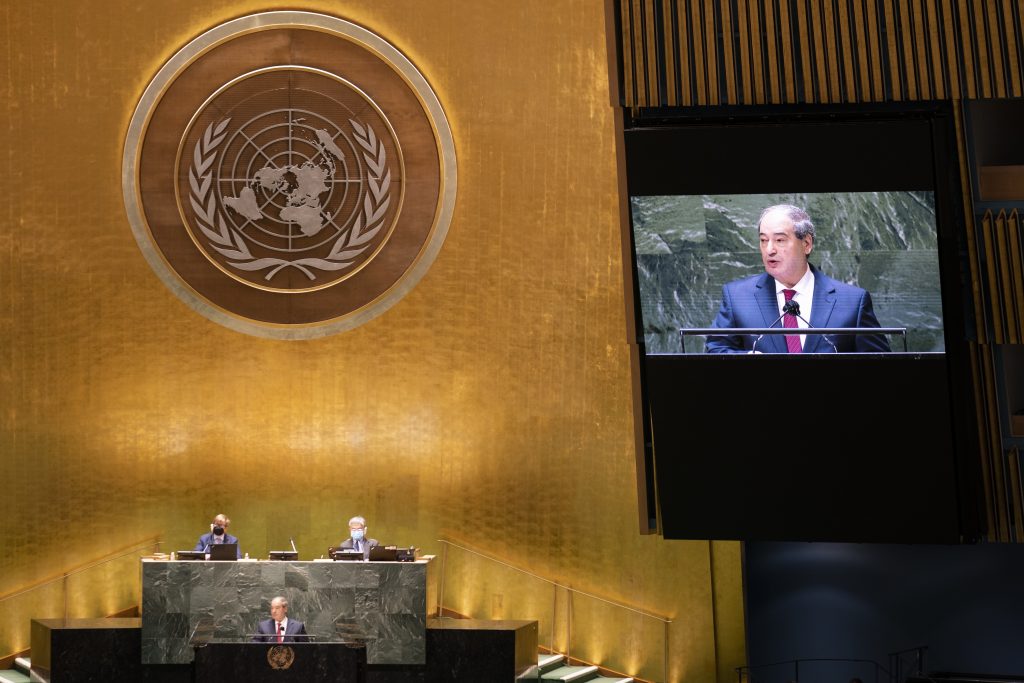
Realizing the Amnesty’s Potential
This latest amnesty decree could be an opportunity for a real breakthrough, but only, it seems, if Damascus is prepared to go further.
It is unclear what Damascus will do next, and if it will take the additional steps its foreign interlocutors have laid out. One diplomat said that Syrian authorities now seemed to be reviewing more cases, but that it remains to be seen if they are prepared to release additional detainees. It’s also unclear whether such releases—if they are forthcoming—are going to be “linked to anything happening in the meantime to acknowledge that gesture, or if they understand they need to act more before getting any gesture back.”61
Damascus’s intentions are difficult to divine. After all, no one really knows why Assad chose to declare this amnesty, and why now. Some diplomats who spoke to me speculated that Arab countries that have lately taken steps to normalize relations with Damascus had encouraged the move, or that Russia had similarly advised its Syrian ally.62 (The United Arab Emirates, for example, has welcomed the amnesty and said it could be considered a confidence-building measure.63) Others said they thought the amnesty decree could be a response to Syria’s dire economic condition, and an attempt by Damascus to pull the country out of what may be an economic death spiral.64 Some also pointed to Pedersen’s persistent advocacy for his “step-for-step” framework. They thought Damascus might have decided, finally, to test what Pedersen could really deliver.65 (Notably, Damascus’s conciliatory messaging of this amnesty has not translated to more constructive engagement by the Syrian government-backed delegation to constitutional committee talks convened by the UN in Geneva.66)
There is reason to doubt that Damascus will commit to a fuller, more transparent implementation of the amnesty decree, which seems like it could impinge on some of the Syrian system’s most essential functions. A more complete picture of Syria’s detainees and detention facilities may expose things that Syria’s security services are intent on keeping hidden.
Damascus’s intentions are difficult to divine. After all, no one really knows why Assad chose to declare this amnesty.
“You have the impression that sharing information hurts them,” said a humanitarian. “That they consider it a form of weakness.”67
Moreover, there may only be a limited window of time in which Damascus can do more to lend the amnesty decree substance. In the view of one Western diplomat, Syrian authorities have only a few months from the decree’s unveiling: “If there’s still nothing verifiable then, then I think all this may just go into the sand.”68
If Damascus is attempting to initiate some reciprocal engagement with its erstwhile foreign adversaries, its approach is more indirect and oblique than some outside interlocutors would like. “They’re not in a negotiation with us,” complained a Western official. “They haven’t agreed to be in the step-for-step process. They did this [amnesty decree] unilaterally, in this chaotic way—how did they imagine it would go? How they conceive of negotiations is completely [messed] up. If you want stuff, then be in a negotiation for stuff.”69
Another diplomat who spoke to me agreed that Syrian officials can sometimes seem to speak in code. “It’s not like they say they want ‘X’ from outside,” he said. “They don’t name their price.” Still, he said, that may also be the only way to deal with them productively: “They won’t act the way the West wants them to act. They’re unlikely to sign up to this conditionality-based framework. But if they actually do important things, and then others do important things, then you could develop a set of actions that, even if they aren’t pre-agreed, could produce progress on an important issue. It’s not ideal, but it’s not bad.”70
If Syrian authorities do go further in implementing this amnesty, then countries that have taken a hard line against Damascus will face tough choices on how to respond. Some officials cannot imagine any plausible number of detainee releases that would be enough to merit a policy change. One Western diplomat said that, measured against the huge numbers of detained and disappeared in Syria, even two or three thousand releases “is not a game-changer.”71
Yet others are more open to engaging, particularly if Damascus furnishes more information and permits outside verification by an organization like the ICRC.72 “Everybody wants this to succeed,” said another Western official. “We’re all willing to laud it if it does.”73
Releases Worth Attempting
This latter official’s conditional readiness to engage seems like the right approach. Foreign officials’ suspicions of Damascus’s intentions are well-founded, and entirely understandable. But verifiable progress on the implementation of this decree—more Syrians out of detention, and more answers for the long-suffering families of Syria’s detainees and disappeared—would be obviously valuable in a way that progress on other, more symbolic tracks in Syria’s political process is not. Freed prisoners are a real, positive thing; constitutional amendments, less so.
Securing the release of Syria’s political detainees is a worthwhile aim that, for Western and other countries, would merit some policy action in return. If the Syrian government does follow through on the steps these countries have outlined, those other countries should be prepared to reciprocate.
Syria’s detention system has been documented in shocking, gruesome detail.74 It is difficult to imagine a return to real normalcy inside Syria and in Syria’s foreign relations so long as the tens of thousands of detentions and disappearances over the past decade of conflict remain unresolved. If Damascus takes real steps to address this issue, though, it could enable progress toward a broader political settlement.
For now, the initiative is with Damascus. Syrian officials know what additional measures would lend real weight to this amnesty, and what could turn Damascus’s initial unilateral gesture into a more fulsome political opening. Now it is for the Syrian government to decide whether this latest amnesty will be, as the foreign minister, Miqdad, told the UN Security Council, truly “exceptional” and “a fundamental turning point” for the country—or just one more paper amnesty.
This report is part of “Networks of Change: Reviving Governance and Citizenship in the Middle East,” a TCF project supported by the Carnegie Corporation of New York and the Open Society Foundations.
Notes
- “President Assad Issues Decree Granting General Amnesty for Terrorist Crimes Committed before April 30, 2022” (in Arabic), SANA, April 30, 2022, http://sana.sy/?p=1639080. For the Counterterrorism Law, see “Law 19 (2012): Counterterrorism Law” (in Arabic), Syrian Arab Republic Parliament, July 2, 2012, http://www.parliament.gov.sy/arabic/index.php?node=55151&cat=4306.
- “The Syrian Regime Has Released 476 People Under Amnesty Decree 7/2022 and Is Still Detaining Some 132,000 of Those Arrested Since March 2011; Amnesty Decree 7/2022 Is the 19th Since March 2011, and 87,000 People Are Still Forcibly Disappeared by the Syrian Regime,” Syrian Network for Human Rights, May 16, 2022, https://snhr.org/blog/2022/05/16/the-syrian-regime-has-released-476-people-under-amnesty-decree-7-2022-and-is-still-detaining-some-132000-of-those-arrested-since-march-2011/. For examples of past amnesties, see “President Assad Issues Decree Granting General Amnesty for Crimes Committed Before June 9, 2014” (in Arabic), SANA, June 9, 2014, https://www.sana.sy/?p=3921; “President Assad Issues Legislative Decree Granting General Amnesty for Crimes Committed Before September 14, 2019” (in Arabic), SANA, September 15, 2019, https://www.sana.sy/?p=1016724.
- For background on the 2012 Counterterrorism Law and its application, see “Syria: Counterterrorism Court Used to Stifle Dissent,” Human Rights Watch, June 25, 2013, https://www.hrw.org/news/2013/06/25/syria-counterterrorism-court-used-stifle-dissent.
- “Major General Kanjo: Decree No. 7 Is Opportunity for Those Released to Return to Fields of Work and Building” (in Arabic), SANA, May 16, 2022, https://www.sana.sy/?p=1649655.
- “Justice Ministry Vacates Notifications and Search, Detention and Summons Notices Related to Crimes Under Counterterrorism Law” (in Arabic), SANA, May 7, 2022, http://sana.sy/?p=1642923.
- Interview with the author, Beirut, July 2022.
- Syrian Network for Human Rights, “The Syrian Regime Has Released 476 People Under Amnesty Decree 7/2022.”
- “The Syrian Regime Released 547 Detainees in Accordance with Decree 7/2022, and Is Still Detaining around 132,000 Individuals,” Syrian Network for Human Rights, July 15, 2022, https://news.snhr.org/2022/07/15/the-syrian-regime-released-547-detainees-in-accordance-with-decree-7-2022-and-is-still-detaining-around-132000-individuals/. The Association of Sednaya Prison Detainees and Missing reported on May 10 that it had documented the release of 136 prisoners. It is not clear how many of those releases were also included in the Syrian Network for Human Rights’ tally. Association of Sednaya Prison Detainees and Missing (@SaydnayaPrison), “Association of Sednaya Prison Detainees and Missing” (in Arabic), Facebook post, May 10, https://www.facebook.com/SaydnayaPrison/posts/pfbid02LR3S7tRfJ4z7uokmDdkf4cw3zF7vR99BYLVMkT1hhq3Fby9wnTzXm4CWfJA3dVuSl.
- Syrian Network for Human Rights, “The Syrian Regime Has Released 476 People Under Amnesty Decree 7/2022.”
- “Head of Terrorism Court Judge Zahera Bashmani on Measures to Implement Amnesty Decree No. 7 (2022)” (in Arabic), published to YouTube by Syrian News TV (syriaalikhbaria), May 4, 2022, https://www.youtube.com/watch?v=h7XsxESQuZY; “Head of Terrorism Court: No Truth to What Is Being Spread About Lists of Those Released Under Amnesty Decree No. 7” (in Arabic), SANA, May 4, 2022, http://sana.sy/?p=1641136.
- SANA, “Major General Kanjo: Decree No. 7 Is Opportunity.”
- SANA, “Justice Ministry Vacates Notifications and Search, Detention and Summons Notices.”
- “Foreign [Ministry] Directs Delegations and Embassies to Receive Syrians’ Requests to Confirm Their Inclusion in Amnesty Decree” (in Arabic), SANA, May 25, 2022, http://www.sana.sy/?p=1656650.
- “Crowds in Syria Await Prisoners Freed in Amnesty,” AFP, May 4, 2022, https://www.france24.com/en/live-news/20220504-crowds-in-syria-await-prisoners-freed-in-amnesty.
- Al-Watan Newspaper (@AlwatanSy), Twitter status, May 3, 2022, https://twitter.com/AlwatanSy/status/1521555366462603264; SANA, “Head of Terrorism Court: No Truth to What Is Being Spread”; “Studio al-Hadath 4 May 2022” (in Arabic), published to YouTube by Syrian News TV (syriaalikhbaria), May 4, 2022, https://www.youtube.com/watch?v=3a0JE_nNE6c.
- Researcher with human rights organization, interview with the author.
- “UN Syria Commission of Inquiry on Syria: Member States Must Seize Moment to Establish Mechanism for Missing Persons,” Office of the High Commissioner for Human Rights, June 17, 2022, https://www.ohchr.org/en/press-releases/2022/06/un-syria-commission-inquiry-syria-member-states-must-seize-moment-establish. The Syrian Network for Human Rights says the Syrian government has detained nearly 132,000 people, including 87,000 who are considered forcibly disappeared. See Syrian Network for Human Rights, “The Syrian Regime Released 547 Detainees in Accordance with Decree 7/2022.”
- SANA, “Justice Ministry Vacates Notifications and Search, Detention and Summons Notices.”
- “Syria: Suspects’ Families Assets Seized,” Human Rights Watch, July 16, 2019, https://www.hrw.org/news/2019/07/16/syria-suspects-families-assets-seized.
- Researcher with human rights organization, interview with the author.
- Association of Sednaya Prison Detainees and Missing, Facebook post, May 10.
- Ibid. Syrian Network for Human Rights, “The Syrian Regime Has Released 476 People Under Amnesty Decree 7/2022.”
- Interview with the author by phone, July 12, 2022.
- Ibid.
- Western diplomat, interview with the author, Beirut, July 2022.
- Interviews with the author, Beirut, July 2022.
- Interview with the author, Beirut, July 2022.
- Ibid.
- Walid Al Nofal, “‘We Hope That He’s Alive’: Thousands of Syrians Gather in Public Squares Looking For Detained Loved Ones Following Amnesty Decree,” Syria Direct, May 5, 2022, https://syriadirect.org/we-hope-that-hes-alive-thousands-of-syrians-gather-in-public-squares-looking-for-detained-loved-ones-following-amnesty-decree-photos-video/; Riham Alkousaa and Kinda Makieh, “Syrians in Berlin Seek Release of Loved Ones after Presidential Amnesty,” Reuters, May 7, 2022, https://www.reuters.com/world/middle-east/syrians-berlin-seek-release-loved-ones-after-presidential-amnesty-2022-05-07/.
- Humanitarian, interview with the author by phone, June 2022.
- For example, see Dera’a Governorate—Local Administration (@salaaaaaamoooo), “Dera’a Governorate—Local Administration” (in Arabic), Facebook post, May 5, 2022, https://www.facebook.com/salaaaaaamoooo/posts/2530712280392747; “Decree No. 7 – Release of a Number of For example, see Dera’a Governorate—Local Administration (@salaaaaaamoooo), “Dera’a Governorate—Local Administration” (in Arabic), Facebook post, May 5, 2022, https://www.facebook.com/salaaaaaamoooo/posts/2530712280392747; “Decree No. 7 – Release of a Number of Detainees in Deir al-Zour Governorate Building” (in Arabic), published to YouTube by Public Radio and Television and Authority (الهيئة العامة للإذاعة والتلفزيون), May 7, 2022, https://www.youtube.com/watch?v=0CnwOt99duM.
- Western diplomat, interview with the author, Beirut, July 2022.
- Maya Ghazi, “Syrian Detainees’ Families Deserve Answers,” Human Rights Watch, May 9, 2022, https://www.hrw.org/news/2022/05/09/syrian-detainees-families-deserve-answers; Syrian Network for Human Rights, “The Syrian Regime Has Released 476 People Under Amnesty Decree 7/2022.”
- “Miqdad Addresses Letter to a Number of Counterparts and to United Nations Regarding Recent General Amnesty: It Represents Efforts to Instill Reconciliation and Mutual Tolerance” (in Arabic), SANA, May 18, 2022, https://www.sana.sy/?p=1651488.
- “Sabbagh: Syria Intent on Mitigating Obstacles to Return of Displaced… Israeli Aggression, Terrorist Crimes and Presence of American and Turkish Forces on Syrian Territory Are There to Extend Chaos” (in Arabic), SANA, June 29, 2022, http://sana.sy/?p=1687013. See also “Sabbagh: Western Countries’ Insistence on Hostile Practices Toward Syria Obstruct Stabilization” (in Arabic), SANA, May 20, 2022, http://www.sana.sy/?p=1653233.
- “Statement by First Deputy Permanent Representative Dmitry Polyanskiy at UNSC Briefing on the Political Situation in Syria,” Permanent Mission of the Russian Federation to the United Nations, June 29, 2022, https://russiaun.ru/en/news/290622s. For more corresponding Syrian and Russian messaging on the amnesty, see “Joint Meeting of Syrian and Russian Coordinating Bodies: Work Continues on Return of All Syrian Displaced and Refugees, Reconstruction” (in Arabic), SANA, June 16, 2022, https://www.sana.sy/?p=1675413.
- “Miqdad and Pedersen Discuss A Number of Topics of Shared Interest” (in Arabic), SANA, May 22, 2022, https://www.sana.sy/?p=1654540.
- Interviews with the author by phone and in Beirut, June and July 2022.
- Interview with the author in Beirut, July 2022.
- Interview with the author by phone, June 2022.
- Interview with the author in Beirut, July 2022.
- “Statement by Deputy Permanent Representative Ambassador Trine Heimerback in the Security Council ‘Arria Formula’ Meeting on ‘Syrian Women’s Voices on Detainees and the Disappeared in Syria,’” Norway in the UN, June 3, 2022, https://www.norway.no/en/missions/UN/statements/security-council/2022/sc-syria2/.
- Ibid.; “Statement by Permanent Representative Ambassador Mona Juul in the Security Council Meeting on the Political Situation in Syria,” Norway in the UN, June 29, 2022, https://www.norway.no/en/missions/UN/statements/security-council/2022/sc-syria-political4/.
- “Remarks by Ambassador Linda Thomas-Greenfield at UN Security Council Arria-Formula Meeting on Detainees and Missing Persons in Syria,” U.S. Mission to the United Nations, June 3, 2022, https://usun.usmission.gov/remarks-by-ambassador-linda-thomas-greenfield-at-un-security-council-arria-formula-meeting-on-detainees-and-missing-persons-in-syria/; “Remarks at a UN Security Council Briefing on the Political Situation in Syria,” U.S. Mission to the United Nations, June 29, 2022, https://usun.usmission.govRemarks by Ambassador Linda Thomas-Greenfield at UN Security Council Arria-Formula Meeting on Detainees and Missing Persons in Syria/remarks-at-a-un-security-council-briefing-on-the-political-situation-in-syria-7/.
- U.S. Mission to the United Nations, “Remarks by Ambassador Linda Thomas-Greenfield at UN Security Council Arria-Formula Meeting.”
- Interview with the author by phone, June 2022.
- “United Nations Special Envoy for Syria Geir O. Pedersen Briefing to the Security Council on Syria,” June 29, 2022, https://specialenvoysyria.unmissions.org/sites/default/files/2022-06-29_secco_un_special_envoy_for_syria_mr._geir_o._pedersen_briefing_as_delivered.pdf.
- Interviews with the author by phone and in Beirut, June and July 2022.
- “Transcript of Press Stakeout of United Nations Special Envoy for Syria Mr. Geir O. Pedersen After Meeting with Minister of Foreign Affairs and Expatriates Mr. Faisal Mikdad,” Office of the Special Envoy of the Secretary-General for Syria, December 12, 2021, https://specialenvoysyria.unmissions.org/transcript-press-stakeout-united-nations-special-envoy-syria-mr-geir-o-pedersen-after-meeting.
- “United Nations Special Envoy for Syria Geir O. Pedersen Briefing to the Security Council on Syria.”
- “Death Notifications in the Syrian Arab Republic,” Independent International Commission of Inquiry on the Syrian Arab Republic, November 27, 2018, https://reliefweb.int/report/syrian-arab-republic/death-notifications-syrian-arab-republic-enar; Louisa Loveluck and Zakaria Zakaria, “Death Notices for Syrian Prisoners Are Suddenly Piling Up. It’s a Sign Assad Has Won the War.” Washington Post, July 26, 2018, https://www.washingtonpost.com/world/death-notices-for-syrian-prisoners-are-suddenly-piling-up-its-a-sign-assads-won-the-war/2018/07/25/43ee2154-8930-11e8-8b20-60521f27434e_story.html.
- For example, see Heather Nauert, “Issuance of Death Notices in Syria,” U.S. Department of State, August 6, 2018, https://2017-2021.state.gov/issuance-of-death-notices-in-syria/index.html; Alistair Burt, “UK Responds to Syrian Regime Releasing Names of Deaths in Detention,” UK Foreign and Commonwealth Office, August 2, 2018, https://www.gov.uk/government/news/uk-responds-to-syrian-regime-releasing-names-of-deaths-in-detention.
- Interviews with the author by phone and in Beirut, June and July 2022.
- “President Assad to Maurer: Priority in Humanitarian Action Must Focus on Areas That Help Improve Lives of Syrians” (in Arabic), SANA, May 9, 2022, http://www.sana.sy/?p=1643958.
- “After Syria Trip, ICRC Head Says Assad ‘Aware of Pressure of International Environment,’” published to YouTube by FRANCE 24 English (FRANCE24English), May 13, 2022, https://www.youtube.com/watch?v=fPKaL6uHZrg.
- Interviews with the author, Beirut, July 2022.
- Wadid Benaabou, “The Regime in Damascus Continues to Oppress Syrians as the War Continues,” https://onu.delegfrance.org/the-regime-in-damascus-continues-to-oppress-syrians-as-the-war-continues
- Interview with the author, Beirut, July 2022.
- Interview with the author by phone, June 2022.
- Interview with the author by phone, June 2022.
- Interview with the author by phone, June 2022.
- Interviews with the author by phone and in Beirut, June and July 2022.
- “UAE Statement at the UN Security Council Arria-Formula Meeting on Detainees and the Disappeared in Syria,” Permanent Mission of the United Arab Emirates to the United Nations, June 4, 2022, https://uaeun.org/statement/uae-arria-3jun22/; “UAE Statement at the UN Security Council Meeting on the Political Situation in Syria,” Permanent Mission of the United Arab Emirates to the United Nations, June 29, 2022, https://uaeun.org/statement/uae-unsc-pol-29jun22/.
- Diplomats, humanitarians, researchers, interviews with the author by phone and in Beirut, June and July 2022. For more on Syria’s economic crisis and its humanitarian effects, see Sam Heller, “Syrians Are Going Hungry. Will the West Act?” Century International, June 7, 2021, https://tcf.org/content/report/syrians-going-hungry-will-west-act/.
- Diplomats, interviews with the author by phone and in Beirut, June and July 2022.
- Most recently, the Syrian government-backed delegation has apparently insisted on a venue change for meetings of the committee. Russia, Damascus’s ally, has objected to meeting again in Switzerland, which Moscow alleges has compromised its neutral status with its positions on the Russian invasion of Ukraine. “Statement on Behalf of the United Nations Special Envoy for Syria Mr. Geir O. Pedersen,” Office of the Special Envoy of the Secretary-General for Syria, July 16, 2022, https://specialenvoysyria.unmissions.org/statement-behalf-united-nations-special-envoy-syria-mr-geir-o-pedersen-3; “Syrian Constitutional Committee Relocation to be Discussed at Astana Troika Summit,” TASS, July 19, 2022, https://tass.com/politics/1481765.
- Interview with the author by phone, June 2022.
- Interview with the author, Beirut, July 2022.
- Interview with the author by phone, July 2022.
- Interview with the author by phone, June 2022.
- Interview with the author, Beirut, July 2022.
- Interviews with the author, Beirut, July 2022.
- Interview with the author by phone, July 2022.
- “If the Dead Could Speak,” Human Rights Watch, December 16, 2015, https://www.hrw.org/report/2015/12/16/if-dead-could-speak/mass-deaths-and-torture-syrias-detention-facilities; Anne Barnard, “Inside Syria’s Secret Torture Prisons: How Bashar al-Assad Crushed Dissent,” New York Times, May 11, 2019, https://www.nytimes.com/2019/05/11/world/middleeast/syria-torture-prisons.html.


